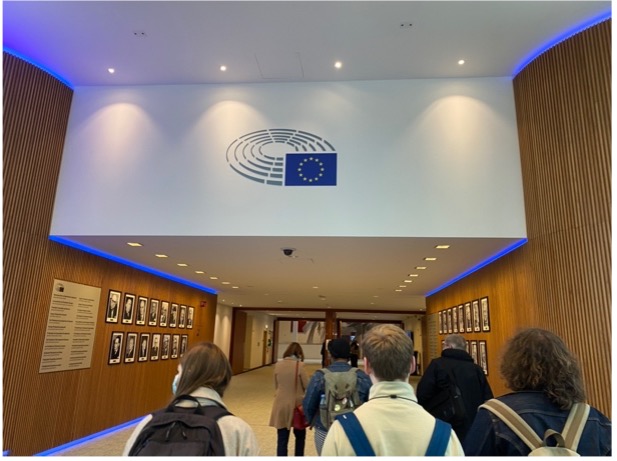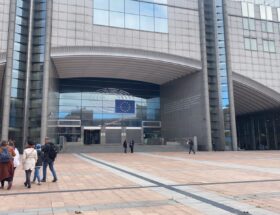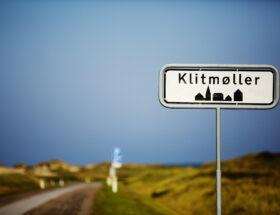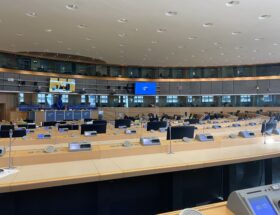[Image of students from the International News Reporting Programme in The EU Commission. CREDIT: Olivia Williams]
By Olivia Williams & Marie Gross
With the UN Climate Change Conference 2021 taking place in Glasgow at the end of October, also known as COP26, the question of the EU’s vision and contribution to the fight against the climate crisis arises.
Ivan Lukač, part of the EU Commission and Coordinator of legal issues, road, rail and waterborne transport says, “One key message in the strategy is that we find that we want the transport sector to become smarter and more resilient and we are really looking at how we can make each mode more sustainable.”
Thus, the Council of the EU has already published a conclusion with its positions on the sixth of October. It states that it is of utmost urgency to strengthen the global response to the climate crisis. But is the EU contributing to this with its self-imposed goals and are these even sufficient?
Lukač states “It’s very important to talk about the fact it’s milestones that are set out for 2030 2035 and 2050 those are aspirational milestones”
With about 25% of greenhouse gas emissions in the EU, transport contributes to around one fifth to one quarter. Through intense political discussion and analytical work, the European Commission has drawn up a Sustainable and Smart Mobility Strategy as part of the Green Deal (The Green Deal is a concept of the European Commission to reduce greenhouse gas emissions in the European Union to zero by 2050.).
The mobility strategy was posted back in December 2019. It is a section within the EU Green Deal – a deal that aims to reduce carbon emissions by 90% by 2050 and use resources more effectively. The strategy itself focuses on the transport systems within the EU and how to make our commute and travel greener, smarter and affordable.
The strategy includes a total of 10 flagship initiatives with 82 initiatives. These flagship initiatives include, for example, more sustainable and healthier mobility between cities and communities (Flagship 3) or putting a price on carbon and creating better incentives for users (Flagship 5).
Shown on the EU official website, you can see the three milestones for 2030, 2035 and 2050, set by the EU Commission to keep the European transport system on course.
By 2030, it strives to have 100 European cities climate neutral and at least 30 million zero-emission cars to be in action on roads. This means that these cities will have to adapt so that the amount of carbon dioxide (CO2) being put into the atmosphere is being balanced with the equal amount being removed.
By 2035, zero-emission large aircrafts will be ready for the market. Zero-emission aircrafts – or Airbus which is what they will be referred to – are commercial aircrafts, fuelled by hydrogen.
By that year, the EU states that all new cars put on the market are to be zero-emission.
“The EU commission’s plans are to devise a new set of emission standards that should help reduce emissions even before 2035 and to make sure that in the coming years the vehicles that are being put on the market before 2035 that their emissions are reduced.” …
… “it will only affect those put on the market after 2035. It doesn’t mean that vehicles produced before 2035 will be banned or forbidden, you can continue driving those.”. Stated by Lukač.
By 2050, the commission wants to reach a fully operating Trans-European Transport Network and have virtually all cars, vans, buses and heavy-duty vehicles to be zero-emission.
The Commission has also provided a clear and thorough 10-point list on the actions they will be taking to reach the set targets. These actions and initiatives can be located through this link.
Other criticism has been made, with claims that politicians are tunnel visioned and focussing too much on electric power and not on other alternatives.
Speaking with Vinciane Perot, who works with European Biogas Association (EBA), he says “We think the whole argument is too much electricity based”.
EBA is a company that advocates for the recognition of biomethane as well as other renewable gases as sustainable and flexible energy sources and are heavily involved with promoting this to the EU.

Perot says “If you look at a renewable fuel, if it is electricity hydrogen cell, methanal or biomethane which we of course are promoting, then every renewable fuel should be looked at in the same way. Meaning, that you should look at the total life cycle of its fuel how it’s being used or, even better, the life cycle of the car”
Mr Perot highlighted that the EU argument was too electricity based and that electricity isn’t as clean as it may seem.
“When you look at a gasoline or diesel car, you know how the gasoline is being produced and how you’re using it in your car and the side effects are CO2 emissions, pollution, all that. When you look at the electric car, we are actually not doing it the same way as they are looking at a gasoline car.”
“For the sake of the electric car, we are only going to look at the car itself and if it has emissions or not. Now that is a little bit strange as electricity being produced is of course not clean. What you are doing with your electric car when you plug it in, most of that will actually be grey electricity and not green, so your car is not actually that green after all.”
Mr Perot did strongly state that he was not against electricity saying “I’m not against electricity by far I think it is a very good solution” but highlighted that the public need to have full knowledge.
“People on the street all think electricity is very green and in principle it can be, it is easy to think that if you plug something in and nothing comes out the exhaust that it is clean.” …
…” but they do not have the full picture and I think people need to be aware that it is not only about the exhaust. It is about the car, how it’s being made, the battery, where it’s coming from and the total life cycle on the emissions. It takes a little more time to explain, which can be difficult for politicians.”
Putting forward a solution to this issue, Perot suggests promoting other renewable fuels such as biomethane, which has the lowest CO2 negative footprint.
“If you look at a renewable fuel, if it is electricity hydrogen cell, methanal or biomethane which we of course are promoting, then every renewable fuel should be looked at in the same way meaning that you should look at the total life cycle of its fuel how it’s being used or even better the life cycle of the car” …
… “Biomethane shows negative emissions, which basically means you can take out methane emissions which normally is a very pulutan greenhouse gas and actually if you take that and burn that into the car, you prevent the methane emissions and actually you can achieve with those negative emissions, meaning you take co2 out of the air” …
…”and as a matter of fact, it is cheaper (methane car). The car itself is cheaper. The car production is happening actually in Europe as well. The ICE (Internal compression engine) technology is European technology.”
He continues to say, “What we are saying to the EU commission is nice that you put electricity forward, but we would advise not to put electric cars forward but green electric cars forward, other renewable fuels are as good sometimes even better and to promote the other fuels doesn’t mean electricity will not be taken up.”
This topic has been discussed by the EU Commission, although they have claimed this would be too difficult to do.
“I think we tried our best to come up with the best possible solution. Of course, time will tell if in some cases we were too ambitious or missed something or if we were not ambitious enough.” says Lukač.
Mr Perot comments “I don’t think they are achievable in the way we have set it up in Europe. So, I think that in 2030, at the review, we will wake up and start thinking about whether all the items we thought we could do are all behind. I am almost certain we will not achieve the amount of green electricity that is needed, we will not achieve the green hydrogen revolution which is needed.”








